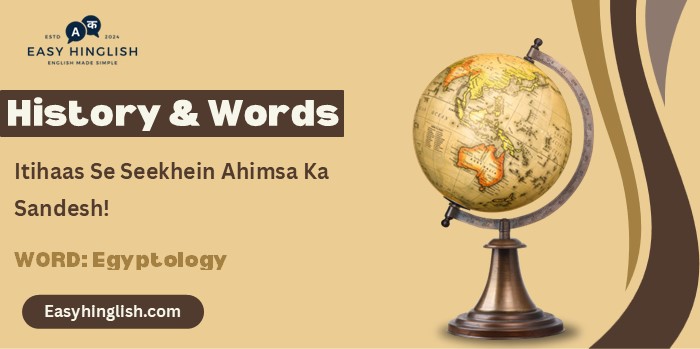History & Words: 'Egyptology' (November 4)
Welcome to 'History & Words.' Main Prashant hoon, Wordpandit aur Learning Inc. Network ka sansthapak. Yeh series meri bhasha seekhne ki lagan aur itihas ke prati ruchi ka sangam hai. Har kadi ek shabd aur uss se judi ek tithi par roshni daalti hai, jisse aapka shabdkosh badhta hai aur aap itihas ko gehraai se samajh paate hain. Aaiye, iss safar mein shabdon ke madhyam se samay mein pichhe chalein.
🔍 Word of the Day: Egyptology
Pronunciation: /ˌiːdʒɪpˈtɒlədʒi/ (ee-jip-TOL-uh-jee)
🌍 Parichay (Introduction)
4 November 1922 ko Valley of the Kings mein desert ki silence achanak excited voices se break ho gayi. Howard Carter aur uski team ne stone steps discover kiye the jo sand ke neeche centuries se buried the. Water boy ne pottery jar stumble kiya tha, jo most important archaeological discovery ki first clue nikla.
Carter ne small hole drill kiya sealed door mein aur candle light kar ke andar peek kiya. "Can you see anything?" Lord Carnarvon ne pucha. "Yes, wonderful things!" Carter ka response Egyptology ki defining moment ban gaya. Tutankhamun's tomb – only intact pharaonic burial ever found – ancient Egypt ko modern world ke saamne live kar diya.
Egyptology sirf academic discipline nahi – yeh human curiosity ka ultimate expression hai. Hieroglyphs se pyramid mysteries tak, mummy curses se golden treasures tak, Egyptology ne popular imagination capture ki hai jaise koi aur field nahi kar saki. 4 November 1922 ne scientific archaeology ko global phenomenon bana diya.
🌱 Shabd ka Utpatti (Etymology)
"Egyptology" ka formation simple hai: "Egypt" + "-ology" (study of). Lekin etymology behind "Egypt" fascinating hai. Greek word "Aegyptos" se aya, jo Arabic "Misr" aur ancient Egyptian "Hwt-ka-Ptah" (house of the soul of Ptah) se derived hai.
Term "Egyptology" 19th century mein formal academic recognition mili, though ancient Egypt ka fascination Greek aur Roman times se exist karta tha. Herodotus (5th century BCE) ko "Father of History" kehte hain, aur usne extensive writings Egypt ke baare mein kiye the.
Modern Egyptology ka birth 1822 mein Jean-François Champollion ke Rosetta Stone decipherment se maana jaata hai. Hieroglyphic script ko crack karne se ancient Egyptian texts readable ban gaye, jo scientific study ka foundation bana.
📖 Mahatvapurn Shabdavali (Key Vocabulary)
- 🔑 Hieroglyphs: Ancient Egyptian writing system using pictorial symbols
- 🔑 Pharaoh: Title of ancient Egyptian rulers, meaning "great house"
- 🔑 Mummification: Process of preserving bodies for afterlife
- 🔑 Sarcophagus: Stone coffin typically decorated with inscriptions
- 🔑 Papyrus: Ancient paper made from reeds, used for writing
🏛️ Itihasik Sandarbh (Historical Context)
Egyptology ka systematic development Napoleon's Egyptian Campaign (1798-1801) se start hua. Description de l'Égypte – massive 23-volume publication – ne European scholarly interest ignite kiya. Rosetta Stone bhi Napoleon's expedition mein discover hua.
19th century mein European powers Egyptian antiquities collect karne mein compete kar rahe the. British Museum, Louvre, Berlin Museum ne major collections build kiye. This period colonial archaeology ka tha, jahan Western institutions Egyptian heritage appropriate kar rahe the.
Flinders Petrie ko "Father of Modern Archaeology" kehte hain. 1880s mein usne scientific excavation methods introduce kiye – stratigraphy, pottery dating, detailed recording. Before Petrie, treasure hunting dominant approach thi scientific study ke bajay.
Egyptian Antiquities Service 1858 mein Auguste Mariette dwara establish hui, first attempt Egyptian heritage ko protect karne ka. Gradually, Egyptian scholars field mein prominent role play karne lage – Ahmed Kamal first Egyptian Egyptologist the (1851-1923).
20th century mein major discoveries ne field revolutionize ki: Deir el-Medina workers' village, Amarna letters, Abu Simbel temples. UNESCO's rescue campaign Aswan High Dam ke time international cooperation ka milestone tha.

⏳ Samayrekha (Timeline)
- 1798-1801 – Napoleon's Egyptian expedition
- 1822 – Champollion deciphers hieroglyphs using Rosetta Stone
- 1858 – Egyptian Antiquities Service established
- 1880s – Flinders Petrie introduces scientific methods
- 1907 – Howard Carter begins work in Valley of the Kings
- 1922 Nov 4 – Discovery of Tutankhamun's tomb entrance
- 1922 Nov 26 – First chamber of tomb opened
- 1960s – Abu Simbel temples relocated
🌟 Is Din ka Mahatva (The Day's Significance)
4 November 1922 ko Valley of the Kings mein extraordinary sequence of events unfold hua. Howard Carter Lord Carnarvon ke financial backing se systematic search kar raha tha last unexplored area mein. Previous season disappointing raha tha, aur Carnarvon funding withdraw karne consider kar raha tha.
Water boy Hussein Abdel Rasoul ne stone step discover kiya debris ke neeche. Carter immediately work halt kar diya aur Carnarvon ko telegram bheja: "At last have made wonderful discovery in Valley; a magnificent tomb with seals intact; re-covered same for your arrival; congratulations."
November 26 ko actual tomb opening hua, lekin November 4 discovery date historically significant hai kyunki entrance confirmation is din hua. Cartouche of Tutankhamun door seals par visible tha, confirming ki yeh boy king ka tomb hai.
Media sensation immediate tha. Times of London ne exclusive rights purchase kiye coverage ke liye, jo international controversy create kar gaya. "Tutmania" global phenomenon ban gaya – fashion, jewelry, architecture Egyptian motifs adopt karne lage.
Scientific importance immense thi. Tomb contained over 5,000 artifacts, perfectly preserved 3,300 years baad. Royal burial practices, craftsmanship, daily life objects ka unprecedented record mila. Carter ne meticulous documentation kiya – photography, cataloguing, conservation ka highest standard maintain kiya.
"Curse of the Pharaohs" popular narrative ban gaya jab Lord Carnarvon 1923 mein died shortly after tomb opening se. Media ne supernatural angle sensationalize kiya, though scientific community rational explanations provide karta raha.
💬 Prasiddh Ukti (Quote)
"Can you see anything?" "Yes, wonderful things!" — Conversation between Lord Carnarvon and Howard Carter, November 26, 1922
🔮 Aaj Ka Matlab aur Chintan (Modern Usage and Reflection)
Aaj Egyptology cutting-edge technology use karti hai ancient mysteries solve karne ke liye. Satellite imagery, ground-penetrating radar, 3D scanning, DNA analysis – modern tools traditional archaeology ko revolutionize kar rahe hain.
Digital Egyptology emerging field hai – virtual museums, online databases, augmented reality experiences ancient Egypt ko global audience ke liye accessible bana rahe hain. Google Arts & Culture, British Museum online millions ko Egyptian artifacts virtually explore karne dete hain.
Decolonization important aspect hai modern Egyptology mein. Egyptian museums, scholars leading role play kar rahe hain their own heritage study karne mein. Repatriation discussions ongoing hain Western museums ke Egyptian collections ke liye.
🏛️ Virast (Legacy)
Tutankhamun's discovery ne Egyptology ko mainstream banaya. Museum attendance worldwide increase hua, archaeological funding badha, academic programs expand hue. Popular culture mein Egyptian themes permanent fixture ban gaye – movies, books, video games regularly ancient Egypt feature karte hain.
Tourism industry mein massive impact hua. Egypt top archaeological destination ban gaya, millions of visitors annually pyramids, temples, museums visit karte hain. Conservation challenges bhi increase hue mass tourism ki wajah se.
🔍 Tulnatmak Vishleshan (Comparative Analysis)
1922 mein Egyptology primarily European domain tha colonial context mein, aaj yeh truly international field hai Egyptian leadership ke saath. Treasure hunting mentality se scientific conservation tak ka transformation remarkable hai. Popular fascination same level par hai, lekin academic rigor significantly improved hai.
💡 Kya Aapko Pata Hai? (Did You Know?)
🎓 Antim Vichar (Conclusion)
Egyptology 4 November 1922 se fundamentally transform ho gaya. Tutankhamun's tomb ne prove kiya ki ancient Egypt inexhaustible source hai human knowledge aur wonder ka. Scientific archaeology aur popular imagination ka unique combination Egyptology ko special place deta hai academic world mein. Modern technology new discoveries possible bana rahi hai, ensuring ki ancient Egypt continue karega future generations ko fascinate karna.
📚 Aage Padhne Ke Liye (Further Reading)
- 📘 The Complete Tutankhamun: The King, the Tomb, the Royal Treasure – Nicholas Reeves
- 📗 A History of Egyptian Archaeology – Jason Thompson
- 📙 The Discovery of the Tomb of Tutankhamun – Howard Carter








